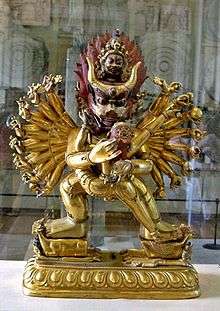Wrathful deities

| Part of a series on |
| Vajrayana Buddhism |
|---|
 |
|
Traditions Historical traditions:
New branches:
|
|
History |
|
Pursuit |
|
Practices |
|
Festivals |
|
Ordination and transmission |
| Vajrayana Buddhism portal |
In Buddhism, wrathful deities are enlightened beings who take on wrathful forms in order to lead sentient beings to enlightenment. They are a notable feature of the iconography of Mahayana and Vajrayana Buddhism. A wrathful deity is often an alternative manifestation of a bodhisattva or other normally peaceful figure, making the representations of all human vices and atrocities. In Tibetan art, wrathful deities are presented as fearsome, demonic beings adorned with human skulls and other bone ornaments (Sanskrit aṣṭhiamudrā).
Wrathful deities are representations of negative karmas, in the same way as peaceful deities are representations of positive karmas. The symbol of the wrathful ones is the kapala, a half skull filled with blood.
Categories
Herukas and Dakinis
Wrathful deities can be divided into several categories:[1]
- The Herukas (Tb. khrag 'thung, lit. "blood drinker") are enlightened masculine beings who adopt fierce forms to express their detachment from the world of ignorance, such as Yamantaka, Cakrasamvara, Mahākāla, or Vajrakilaya. Dakinis are their feminine counterparts, sometimes depicted with a heruka and sometimes as independent deities. The most prevalent wrathful dakinis are Vajrayogini and Vajravārāhī.
Wisdom Kings or Vidyaraja
- The Wisdom Kings (Sanskrit vidyarāja), known particularly as the protectors of the Five Dhyani Buddhas; more a feature of Japanese than Tibetan Buddhism
The Protectors
- The Protectors (Sanskrit pāla) or Dharmapāla, are often subdivided into three categories:
- Lokapālas or "Protectors of the World" are the guardians of the four cardinal directions;
- Kṣetrapālas or "Protectors of the Region"; and
- Dharmapāla or "Protectors of the Law". These vary in the level of realization attributed to them. This can be anything from fully enlightened to an oath-bound worldly spirit. Most of the major Dharmapalas are said to be enlightened.
Eight Dharmapalas
Among the Dharmapāla, one of the most common categories are 'The Eight Dharmapalas' (Tibetan: དྲག་གཤེད, Wylie: drag gshed ), who are understood to be the defenders of Buddhism. They are supernatural beings with the rank of bodhisattva who "are supposed to wage war without any mercy against the demons and enemies of Buddhism".[2] The Eight Dharmapala are:
- Yama, the god of death;
- thinhwang, the Great Black One;
- Yamantaka, the conqueror of death;
- Vaiśravaṇa or Kubera, the god of wealth;
- Hayagriva, the Horse-necked one;
- Palden Lhamo;
- Brahma; and
- Begtse, a war god.
See also
- Buddhist deities
- Chinese mythology
- Hindu mythology
- Japanese mythology
- Korean mythology
- Vajrapani
- Vajravarahi
References
- ↑ Wrathful Deities
- ↑ "Wrathful Guardians of Buddhism - Aesthetics and Mythology". February 2001. Retrieved 2008-08-31.
External links
- Wrathful Guardians of Buddhism - Aesthetics and Mythology
- Wrathful Deities
- Sacred visions : early paintings from central Tibet, fully digitized text from The Metropolitan Museum of Art libraries